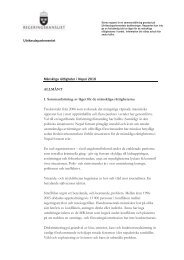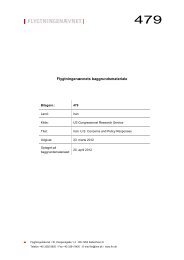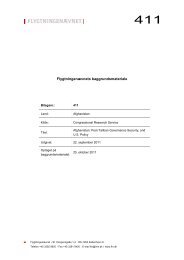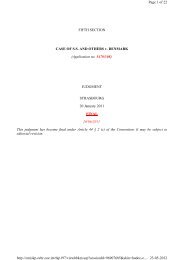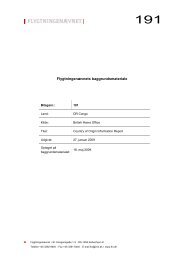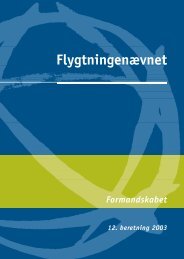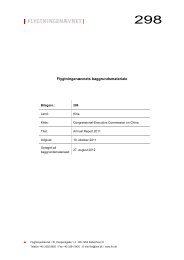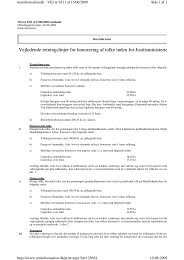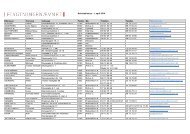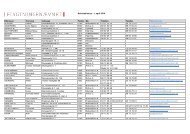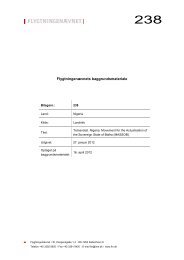Annual Report - National Human Rights Commission
Annual Report - National Human Rights Commission
Annual Report - National Human Rights Commission
Create successful ePaper yourself
Turn your PDF publications into a flip-book with our unique Google optimized e-Paper software.
Annexure 12<br />
○ ○ ○ ○ ○ ○ ○ ○ ○ ○ ○ ○ ○ ○ ○ ○ ○ ○ ○ ○ ○ ○ ○ ○ ○ ○ ○ ○ ○ ○ ○ ○ ○ ○ ○ ○ ○ ○ ○ ○ ○ ○ ○ ○ ○ ○ ○ ○ ○ ○ ○ ○ ○ ○ ○ ○ ○ ○ ○ ○ ○ ○<br />
○<br />
has been trafficked to India across borders, she/he should not be held to be an illegal immigrant.<br />
Temporary residential permits should be provided in such cases.<br />
Timeframe for Justice Delivery<br />
As per the existing procedural law (Section 167 Cr.PC), there is a restriction on the time that the<br />
police can avail for investigation after the arrest of the person. Similar timeframe should be set<br />
for the trial of the cases in the courts of law also, without any prejudice in the delivery of justice<br />
to the victim. The available literature shows that a similar provision is available in Bangladesh<br />
for ensuring time-bound judicial trial of trafficking cases, and that this arrangement is working<br />
quite well, especially with regard to expediting justice delivery.<br />
Punishments<br />
There is a need to enhance the punishments for traffickers and other exploiters. The provisions<br />
have to be made more stringent. Minimum punishment should be prescribed for all penal sections.<br />
Enhanced punishment is called for when the victim is a child.<br />
<strong>National</strong> Nodal Agency to Monitor <strong>Human</strong> Trafficking<br />
The rationale for setting up a <strong>National</strong> Nodal Agency to counter trafficking has been discussed<br />
earlier. It would be appropriate if the provision is incorporated in the law itself by providing a<br />
separate section/subsection in ITPA.<br />
Rehabilitation<br />
Rehabilitation is the creative essence of the preventive process and essential to the healing process.<br />
Therefore, there should be one exclusive chapter in the ITPA on correctional justice and<br />
rehabilitation, dealing with the ‘drills, process, medical treatment, monitoring, follow-up action,<br />
and other distressing and mainstreaming techniques’. Social activists and NGOs should be<br />
statutorily encouraged to involve themselves in rehabilitation.<br />
Prevention<br />
This should be the summum bonum in a social legislation like ITPA. Justice Iyer says, “Today<br />
we should not put all our eggs in the Macaulay basket, but in the Mahatma pharmacopoeia.”<br />
Accordingly, there should be a separate chapter in the ITPA on Prevention, specifically bringing<br />
out the human rights perspective required in the policies, programmes and implementation. The<br />
chapter should spell out the procedures and role of agencies — governmental and nongovernmental<br />
— in this regard. Preventive strategies should be oriented not only to the source<br />
of supply, but also to the demand site as well as trafficking routes and transit points. The present<br />
legislation (ITPA), which is more focused on the crime-criminal perspective, needs to be given<br />
a human rights perspective and make it fully oriented towards prevention.<br />
Provision for the Handicapped<br />
There should be a specific provision in the law for offences against women and children who<br />
302<br />
<strong>National</strong> <strong>Human</strong> <strong>Rights</strong> <strong>Commission</strong> <strong>Annual</strong> <strong>Report</strong> - 2004-2005<br />
AR-Chapter-1-19-10-6-06.p65<br />
322<br />
7/17/06, 6:31 PM



